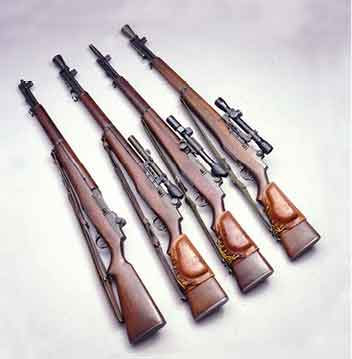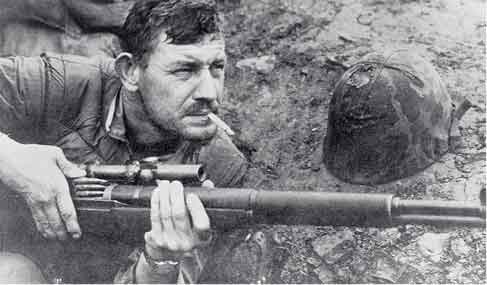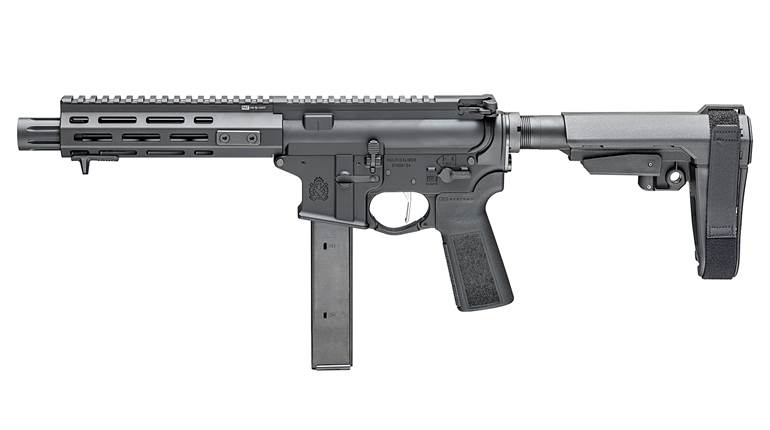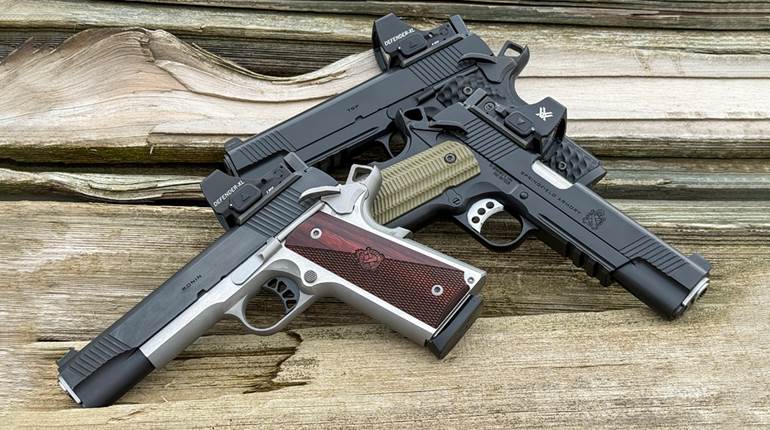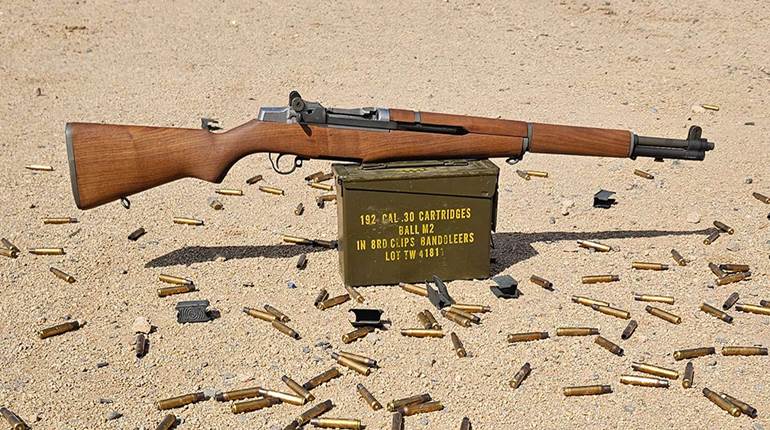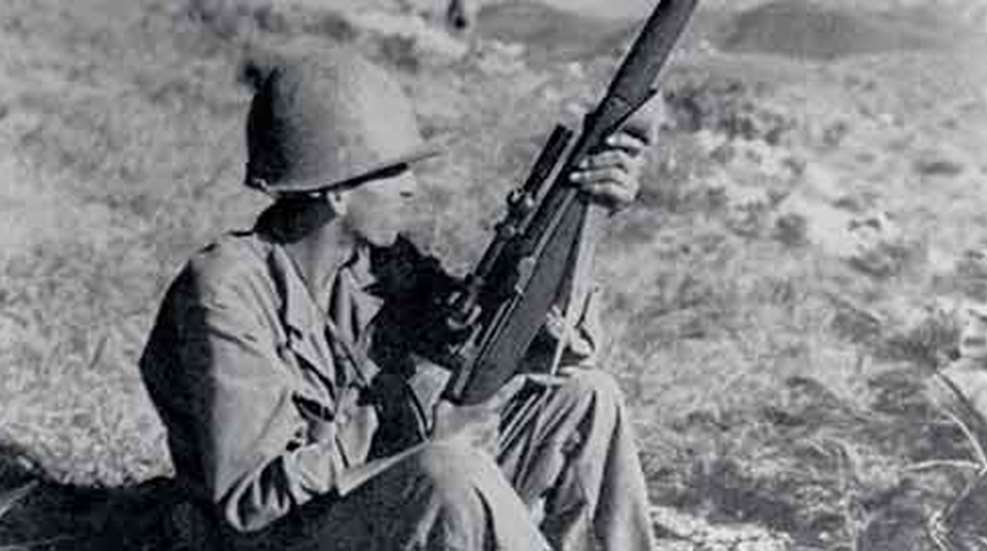
At the time of the Pearl Harbor attack, the U.S. Army did not have a standardized sniper rifle. Early in the war, the Army Ground Forces requested that a sniper version of the M1 Garand rifle equipped with a telescopic sight be developed. However, it was immediately apparent that the M1 rifle’s action would require an entirely different approach than most bolt-action sniper rifles—which mounted a telescope directly over the receiver. Since the M1 had to be loaded from the top, a telescope mounted in such a location would not be feasible. The U.S. Army Ordnance Dept. tested several possible solutions—including a prismatic telescope with the eyepiece centered over the M1’s rear sight but with the body of the scope offset to provide the necessary clearance for the action. While it and other M1 rifle-based sniper designs were evaluated, a slightly modified Remington Model 1903A3 bolt-action rifle was adopted in early 1943 as the “U.S. Rifle, Caliber .30, M1903A4, Snipers” as more or less an interim measure. Sizeable numbers of ’03A4 sniper rifles were produced and widely issued during the war until a satisfactory Garand sniper rifle could be developed.
Testing of the several proposed designs for M1 sniper rifles concluded that the best solution would be to mount the telescope on the left side of the receiver so normal functioning of the rifle would be unaffected. Such an offset location required a leather cheek pad be attached to the stock to properly position the shooter’s face, but that was not viewed as a serious detriment.
Two prototype Garand sniper rifles designed to mount a scope on the left side of the receiver were eventually selected and differed primarily in the configuration and placement of the scope base and mount. The first design, designated as the “M1E7,” featured a bracket fastened to the left side of the receiver for a telescope mount. Both the bracket and mount were developed by the well-known civilian firm of Griffin & Howe. Five holes were drilled into the side of the M1C receiver for attachment of the mounting bracket. Three of the holes were threaded for screws and two were for taper pins to hold the bracket in alignment while it was assembled. Otherwise, the rifle’s configuration remained unchanged. The rifle was eventually adopted on July 27, 1944, as the “U.S. Rifle, Cal. .30, M1C, Snipers.”
The other design was the “M1E8,” which featured a base permanently attached to the rear of the barrel. The barrel-mounted base was designed to accept a scope mount with a large knurled knob that permitted the scope to be quickly removed. The M1E8 base and mount were designed by John Garand. The design was eventually adopted as the “U.S. Rifle, Cal. .30, M1D, Snipers.”
Although both designs were standardized, for several reasons it was decided by Ordnance to put the M1C into production rather than the M1D. As initial production began, the receivers were heat-treated with the mounting bracket installed. But it was eventually discovered that the different composition of metallurgy between the two components could cause the assembled unit to warp. When this defect was discovered, the procedure was changed and the receivers and brackets were heat-treated separately prior to assembly. Other production glitches that negatively affected the accuracy of the new Garand sniper rifles were encountered but most were eventually solved.
The M1C serial numbers were in the approximate 3,100,000 to 3,800,000 range. While the M1 receivers used to fabricate M1C rifles were regular Springfield Armory production, they were selected in distinct “batches” or “blocks.”
The “M73” telescopic sight was standardized for use with M1C rifle in October 1944. This scope, made by the Lyman Co., was the military’s designation for the company’s “Alaskan” all-weather scope. The scope was later modified by the addition of a sliding rain/sun shade on the objective end, and the modified scope was re-designated “M81.” The magnification was 2.2X, and the scope had a crosshair reticle. The M81 was soon superseded by the M82 which differed mainly in the substitution of a tapered post for the crosshair reticle.
In order to help conceal a sniper’s position and reduce the possibility of muzzle flash from temporarily blinding the shooter when firing in low-light conditions, such as dawn or dusk, a conical flash hider was adopted on January 25, 1945, as the “Hider, Flash, M2.” The M2 flash hider slipped over the muzzle and was secured in place by clamping onto the rifle’s bayonet lug. It was eventually superseded after the war by the “T37” flash hider. It was not uncommon for the flash hiders to be removed as they were of only marginal use and could negatively affect the accuracy of the rifle.
The initial M1C contract during World War II called for the manufacture of 21,158 rifles. Various problems were encountered, though, including the lack of telescopes and accuracy problems that had to be addressed. This resulted in production falling woefully short of projections, only 7,971 complete M1C rifles were manufactured during World War II. The manufacturing problems and shortage of telescopes severely hampered delivery of the rifles and it was not until, literally, the closing days of the war in the Pacific that M1Cs began to see service. At the conclusion of the war, the M1C was the standardized U.S. military sniping rifle and the M1D was designated “Substitute Standard.”
As hostilities heated up on the Korean peninsula in 1950, demands were soon coming in from the using services for sniper rifles. Other than the relative handful of M1C rifles fielded very late in the conflict, the U.S. Army and U.S. Marine Corps fought World War II with bolt-action sniper rifles. In order to meet the sudden demand, plans were formulated in early 1951 to put the M1C sniper rifle back into production.
Springfield Armory records indicate that a total of 4,796 M1C rifles were manufactured in the 1951-1953 period. Many, if not all, of these post-World War II M1C rifles were fabricated using some of an estimated 18,000 to 19,000 M1C receivers remaining in storage at the Armory since 1945. These receivers had the five holes drilled in the side, but were never assembled into complete rifles during World War II. It is doubtful if any meaningful number of these newly minted early 1950s assembled Garand sniper rifles made it to Korea prior to the cessation of hostilities. Thus, the M1Cs used in that conflict were likely World War II production rifles.
Since the M1C rifles fabricated in the early 1950s apparently utilized World War II receivers previously drilled and tapped by Griffin & Howe during that war, those receivers were serially numbered in the original M1C range. After attaching the bracket to the receiver, the rifles would be essentially the same as the World War II-assembled M1Cs except for the barrel dates and several other minor details. While functionally identical, there were three distinct types of M1C rifles in U.S. service that can be categorized by the following characteristics:
World War II Production (late 1944 to late 1945)• Springfield Armory barrels, generally dated from late 1944 to late 1945. However, some 1943 (or even earlier) dated barrels from a contingency reserve are believed to have been used by Springfield Armory to facilitate M1C production in World War II.
• Griffin & Howe receiver bracket with the serial number of the rifle stamped on the bottom. A very small number may have been assembled with unnumbered brackets.
• Griffin & Howe blued scope mount with rifle serial number stamped on the side by Springfield Armory. M81 or M82 telescope. Very early examples may have utilized Lyman M73 scopes.
1951-1952 Assemblage• Springfield Armory barrel generally dated 1951 or early 1952.
• Griffin & Howe receiver bracket with rifle serial number stamped on the side.
• Griffin & Howe blued scope mount with rifle serial number stamped on the side. Receiver and mount serial numbers invariably mismatched.
• M81, M82 or Lyman (B-prefix serial number) Alaskan scopes.
Post-War Rebuilds
While the majority of examples will be found with Springfield Armory barrels dated in the 1950s, new production barrels, or barrels salvaged from previously overhauled rifles, could also have been utilized.
• Griffin & Howe receiver brackets, either World War II or early 1950s vintage, often with mismatched bracket/receiver serial numbers or unnumbered.
• Griffin & Howe scope mount either blued or Parkerized. Generally stamped with the rifle serial number and invariably mismatched.
Depending on the time frame of the rebuild, the telescope could be any of the above or the M84. The M84 did not fit the M1C mount very well because of interference with the rubber eyepiece which often resulted in removal of the eyepiece.
The only M1C rifles known to have been assembled by Springfield Armory after World War II were the 4,796 cited above. The remaining M1C receivers unused since 1945 subsequently had the five screw holes plugged and were utilized by Springfield Armory to assemble service rifles in the 1952 period. The receivers used for rebuilds in 1952 were marked “SA-52” behind the rear sight to denote rebuild at the Armory in that year. Additionally, some extant standard M1 rifle receivers (not M1C receivers) were also marked in this manner and used for rebuild purposes in 1952.
Although it had been selected as the standardized U.S. military sniping rifle, the drawbacks inherent to the M1C became increasingly apparent in the post-war period. The M1D sniper rifle, on the other hand, was much simpler to make and shared few of the M1C’s disadvantages. As early as 1951, it was clear that the M1D, and not the M1C, was soon to be the favored design. This is evident as some 21,380 M1D rifles were manufactured as compared to fewer than 5,000 M1C rifles during 1951-1953. In addition, Springfield Armory made more than 12,000 spare M1D barrels that could be used to convert additional service rifles into M1D sniper rifle configuration at some future date.
By 1953, the M1D was the primary U.S. military sniper rifle. Most of the M1Cs were rebuilt, and many were sent to ostensibly friendly nations under various military aid programs. The majority of M1C rifles were subsequently rebuilt one or more times and can reflect a variety of barrel dates and overhaul markings.
USMC 1952 Sniper Rifle A little-known, but very interesting, variation of the M1C rifle was developed by the U.S. Marine Corps in the early 1950s. The U.S. Marine Corps’ already limited supply of sniper rifles was quickly depleted because of the Korean War. The Marines needed additional sniper rifles but desired to procure the best type of rifle and scope combination available.
On Feb. 9, 1951, the Commandant of the Marine Corps ordered the USMC Equipment Board to test and evaluate sniping equipment, both military and commercial, to determine which would best meet the Corps’ needs. After extensive testing, the Board issued a report stating that the commercial Stith Bear Cub was the best available telescope. The Marine Corps Equipment Board’s Report was approved and the resultant rifle was designated as the “USMC 1952 Sniper’s Rifle.” Sometimes referred to as the “MC 52,” the rifles were M1Cs, either World War II production or early 1950s conversions, fitted with special 4X telescopes manufactured for the Marine Corps by the Kollmorgen Optical Co. The scope was based on the Stith commercial Bear Cub telescope as previously recommended by the USMC Equipment Board. The “Telescopic Sight - Model 4XD-USMC” was designated as the “MC-1.”
The USMC 1952 rifle retained the standard Griffin & Howe receiver bracket but was fitted with a Griffin & Howe mount adapted to the Kollmorgen telescope. It differed somewhat from the standard Griffin & Howe M1C mount in size and configuration but was functionally identical. The mount was given the same “MC-1” designation as the Kollmorgen telescope. If the original late 1944 or 1945 Springfield barrel was serviceable, it could be retained for use on the USMC 1952 rifles but, in most cases, new production Springfield barrels (generally early 1950s dated) were installed as part of the overhaul procedure. During the post-war rebuild, new stocks were typically added, often with “SA” rebuild markings stamped on the left side.
Like the post-World War II M1C and M1D rifles, it is doubtful if any of the USMC 1952 sniper rifles were fielded during the Korean War. The rifles remained in the Marine Corps’ inventory from circa 1954 to 1967. Sniper historian and former Marine Corps sniperMaj. Edward J. Land, Jr. reported that “A number of these rifles were glass-bedded by Marine Armorers in Hawaii (1961-1962) and Vietnam (1966).” Nonetheless, the acquisition of modern bolt-action sniper rifles such as the Remington M40 marked the end of the USMC 1952 Garand sniper rifles in Marine Corps service. Genuine USMC 1952 rifles are quite uncommon on the collector market, but a number of rifles have been assembled using surplus MC-1 mounts and Kollmorgen scopes in an attempt to replicate the configuration. Genuine examples of USMC 1952 sniper rifles with unquestioned Marine Corps provenance are rarely seen today.
Although superseded by the M1D soon after the conclusion of the Korean War, the M1C was our nation’s first semi-automatic sniper rifle produced in quantity and is very popular with collectors today. The CMP began selling some M1C rifles to qualified purchasers in the mid-1990s via auction. Those rifles sold quickly, and genuine M1C rifles continued to be rather elusive on the collector market until early 2011 when the CMP began selling M1C rifles that had been returned by the Greek government. As with the earlier CMP auction rifles, all of these had been rebuilt after World War II. Many were sold with the receiver mounting bracket attached but did not have a mount or telescope. That resulted in the already limited supply of proper scopes and genuine scope mounts becoming increasingly harder to find (and much more expensive) as buyers of the CMP M1C rifles sought to find the components necessary to complete their rifles.
Today, an original M1C rifle remaining in its World War II configuration is quite uncommon and is a highly prized martial arm. Indeed, any genuine M1C rifle is an extremely collectible—and historic—arm. While the M1C was not the optimum sniper rifle, it was further testimony to the versatility of John Garand’s masterpiece.
Further Reading:
The M1 Garand Rifle
Longtime American Rifleman Field Editor Bruce N. Canfield’s serious, expansive piece of scholarship on the most important American military rifle of the 20th century, The M1 Garand Rifle, came as result of working with top Garand scholars and collectors, primary documents and thousands of surviving M1s. Canfield describes the development of the military semi-automatic rifle before the M1, then offers an overall narrative of the rifle, its manufacture and evolution at each factory that produced it, as well as the part-by-part description of every known variant of each part on the rifle. The author had access to the files of Winchester’s Edwin Pugsley, which provide not only unique insight into the manufacture of the Winchester M1s, but also American firearm manufacturing in general from the 1930s through the post-World War II era. American and foreign use of the rifle are covered, as are the many accessories for the M1, ranging from all the known manufacturers of the eight-round en bloc clip, to bayonets, to cartridge belts to sighting tools. It is a remarkable resource on America’s greatest rifle.
The 8½"x11" hardbound book has 872 pages and more than 2,150 images, many of which are reproduced in color. The price is $96 plus shipping, and it is available through Mowbray Publishing, 54 E. School St., Woonsocket, RI 02895; (800) 999-4697; gunandswordcollector.com. —Mark A. Keefe, IV, Editor In Chief

